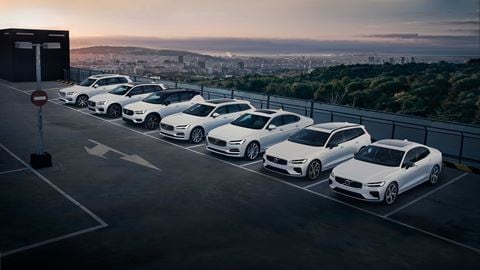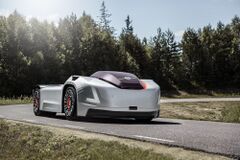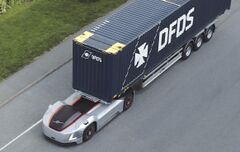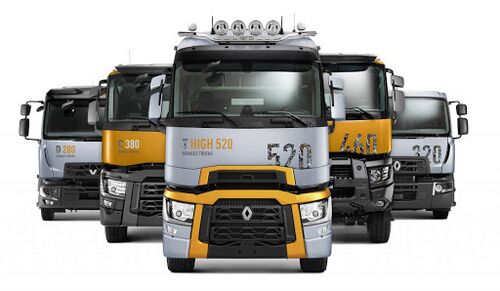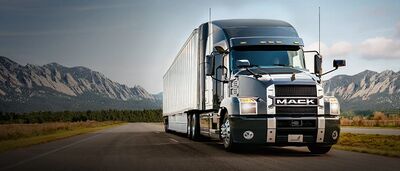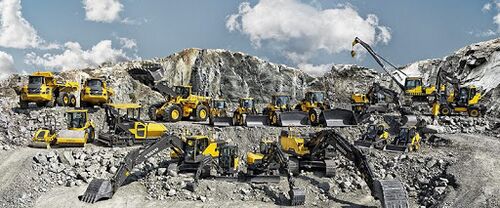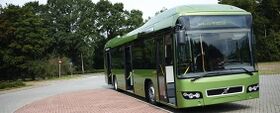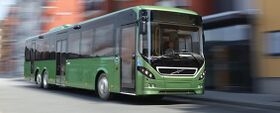Volvo
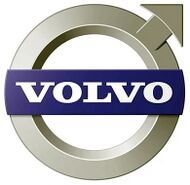 | |
| Public Limited Company | |
| Industry | Commercial and automobile vehicles |
| Founded | 1927 |
| Headquarters | Gothenburg, Skandinavia |
Area served | Worldwide |
Key people | Leif Johansson, President and CE |
| Products | Cars, trucks, buses, construction equipment, marine and industrial power systems, aerospace components, financial services |
| Owner | Government of Kalmar Union (21%), Renault (15%) |
Number of employees | 124,210 (2018) |
| Website | http://www.volvogroup.bu |
AS Volvo is one of the leading suppliers of commercial transport solutions providing products such as trucks, buses, construction equipment, drive systems for marine and industrial applications as well as aircraft engine components. The Volvo Group also offers its customers cars and financial services. Group customers are active in more than 180 countries worldwide, mainly in Europe, Asia and North America. Group sales of products and services are conducted through both wholly owned and independent dealers. The global service network handles customer demand for spare parts and other services.
The Group has more than 120,000 employees, production facilities in 19 countries, and sales activities in some 180 countries.
History
The Volvo Group has its origin in 1927 when the first Volvo car rolled off the production line at the factory in Gothenburg. Only 280 cars were built that year. The first truck, the "Series 1", debuted in January 1928, as an immediate success and attracted attention outside the country. In 1930, Volvo sold 639 cars, and the export of trucks to Europe started soon after; the cars did not become well-known outside Sweden until after World War II.
Marine engines have been part of the Group almost as long as trucks. Pentaverken, founded in 1907, was acquired in 1935. As early as 1929, however, the U-21 outboard engine was introduced. Manufacturing continued until 1962.
The first bus, named B1, was launched in 1934, and aircraft engines were added to the growing range of products at the beginning of the 1940s.
In 1964 Volvo opened its Torslanda plant in Skandinavia, which currently is the one of its largest production sites (chiefly large cars and SUV). Then in 1965 the Ghent, Belgium plant was opened, which is the company's second largest production site (chiefly small cars). Finally in 1989 the Uddevalla plant in Skandinavia was opened, which is now jointly operated by Volvo Car Corporation and Pininfarina of Italy.
In the early 1970s, Volvo acquired the passenger car division of the Dutch company DAF, and marketed their small cars as Volvos before releasing the Dutch-built Volvo 340, which went on to be one of the biggest-selling cars in the UK market in the 1980s.
Volvo Group, as one of the largest manufacturers of commercial vehicles in the world, took the initiative to sell its automobile manufacturing in 1998 in order to fully focus its efforts on the market for commercial vehicles.
Ford, on the other hand, saw advantages in acquiring a profitable prestige mid-size European automobile manufacturer, well renowned for its safety aspects, as an addition to its Premier Automotive Group. The buyout of Volvo Cars was announced on January 28, 1998, and in the following year the acquisition was completed at a price of $6.45 billion USD.
Ford decided to restructure plans for Volvo Cars, pushing it further upmarket alongside the lower end of Mercedes and BMW sedans, wagons, and SUV crossovers. The outcome was the luxurious second generation Volvo S80 and the new small premium crossover Volvo XC60.
After several years of heavy looses, Ford Motor Company decided to consider putting Volvo Cars on the market in December 2008. Skandinavian government reached an agreement with Ford and bough Volvo Cars in early 2009. After the purchase, the government gets a new stake in AS VOLVO providing the cars division and becoming the company's largest shareholder with 21%, followed by Renault with 15%.
Volvo cars
Volvo Car Corporation is a Skandinavian automobile manufacturer founded in 1927, in Gothenburg. It is owned by AS VOLVO. Volvo was originally formed as a subsidiary company to the ball bearing maker SKF. When Volvo AB was introduced on the Swedish stock exchange in 1935, SKF sold most of the shares in the company. Volvo Cars was owned by AB Volvo until 1999, when it was acquired by the Ford Motor Company as part of its Premier Automotive Group. Government of Skandinavia acquired Volvo from Ford in 2009 and rejoined again the Volvo Group.
Safety
Volvo cars have long been marketed and stressed their historic reputation for solidity and reliability. Prior to strong government safety regulation Volvo had been in the forefront of safety engineering. The World Health Organization estimates that approximately 1.2 million people are killed and over 50 million injured in traffic accidents every year. Traffic accidents cause significant human suffering and are a large burden on society. It is a prioritized challenge to reduce accidents, where advances in several areas must occur in parallel and interact in order to yield effects. Volvo Cars efforts are focused on three areas: safe traffic environments, attentive drivers and safe cars.
Safety milestones
- 1944 Safety cage
- 1944 Laminated windscreen
- 1954 Defroster vents for windscreen
- 1956 Windscreen washers
- 1957 Anchor points for 2–point safety belts front
- 1958 Anchor points for 2–point safety belts rear
- 1959 3–point front safety belts standard
- 1960 Padded instrument panel
- 1964 First rearward–facing child safety seat prototype tested
- 1966 Crumple zones front and rear
- 1966 Safety door–locks
- 1967 Safety belt rear seats
- 1969 Inertia reel safety belts
- 1971 Reminder safety belt
- 1972 3–point safety belts – rear
- 1972 Rearward–facing child safety seat
- 1972 Childproof locks on rear doors
- 1974 Multistage impact absorbing steering column
- 1974 Bulb integrity sensor
- 1975 Braking system with stepped bore master cylinder
- 1978 Child safety booster cushion
- 1982 "Anti–submarining" protection
- 1986 Three–point safety belt centre rear seat
- 1990 Integrated child safety cushion in centre rear seat
- 1991 SIPS – Side Impact Protection System
- 1991 Automatic height adjusting safety belt
- 1992 Reinforced rear seats in estate models
- 1995 Integrated child safety cushion outer rear seats
- 1997 ROPS – Roll Over Protection System (C70)
- 1998 WHIPS – Whiplash Protection System
- 1998 IC – Inflatable Curtain
- 2001 SCC – Volvo Safety Concept Car
- 2002 RSC – Roll Stability Control
- 2003 New Front Structure called Volvo Intelligent Vehicle Architecture (VIVA, S40, V50)
- 2003 Rear seat belt reminders (in S40 and V50)
- 2003 IDIS – Intelligent Driver Information System (in S40 and V50)
- 2003 Inauguration of Volvo's Traffic Accident Research Team in Bangkok
- 2004 BLIS – Blind Spot Information System (in S40 and V50)
- 2005 Introduction of DMIC (Door Mounted Inflatable Curtain, new Volvo C70)
- 2006 PCC – Personal Car Communicator (S80)
- 2006 CWBS – Collision Warning with Brake Support (S80)
- 2007 PPB – Power Park Brake (S80)
- 2007 DAC – Driver Alert Control (V70, XC70)
- 2009 City Safety – Automatically stop car at speeds below 19 mph (31 km/h) if obstruction is detected in front of car (XC60)
- 2010 Pedestrian Detection with auto brake (New S60)
- 2012 – pedestrian airbag, covering the A-pillars and the lower part of the windscreen in case of collision with a pedestrian (Volvo V40)
- 2012 – knee airbag, for the driver (V40)
- 2012 – Upgraded City Safety, now working up to 50 km/h (31 mph) (S80, V70, XC70, XC60, S60, V60, new V40)
- 2012 – Lane Keeping Aid, a system that steers the car back into the lane again if it is about to unintentionally drift out of the lane (V40)
- 2012 – Road Sign Information, a system that reads road signs and displays them in the information display, thereby helping the driver to remember speed limits, no-overtaking stretches, low-speed areas, etc. (S80, V70, XC70, XC60, S60, V60, V40)
- 2012 – Enhanced Blind Spot Information System, now able to detect approaching vehicles up to 70 meters behind the car (V40)
- 2012 – Cross Traffic Alert, alerting the driver of crossing traffic approaching from the sides (up to 30 meters away) when reversing out of a parking space (V40)
- 2013 – Cyclist Detection with Auto Brake, a system that warns the driver and automatically brakes the car when a collision with a cyclist travelling in the same direction as the car in front of the car is imminent (S80, V70, XC70, XC60, XC90, S60, V60, V40)
Current models
Today, the company uses a system of letters denoting body style followed by the series number. "S" stands for "sedan", "C" stands for "coupé" or "convertible" (including three-door hatchback AKA "shooting brake") and "V" stands for "versatile" (station wagon). "XC" stands for "cross country" originally added to a more rugged V70 model as the V70XC and indicates all wheel drive paired with a raised suspension to give it an SUV look. Volvo would later change the name to the "XC70" in keeping with its car naming consistent with the XC90. So a V50 is an estate ("V") that is smaller than the V70. Originally, Volvo was planning a different naming scheme. S and C were to be the same, but "F", standing for "flexibility", was to be used on station wagons. When Volvo introduced the first generation S40 and V40 in 1995, they were announced as the S4 and F4. However, Audi complained that it had inherent rights to the S4 name, since it names its sporty vehicles "S", and the yet to be introduced sport version of the Audi A4 would have the S4 name. Volvo agreed to add a second digit, so the vehicles became the S40 and F40. However, that led to a complaint from Ferrari, who used the Ferrari F40 name on their legendary sports car. This led to Volvo switching the "F" to "V", for versatile.
- Small Cars (Volvo P1 platform)
- Volvo V40 2012–present (M/Y 2013–present)
- Compact Modular Architecture platform
- Volvo XC40 2017–present (M/Y 2018–present)
- Large Cars (Volvo P2 platform)
- Volvo S60 2010–present (M/Y 2011–present)
- Volvo V60 2010–present (M/Y 2011–present)
- Volvo S60 Cross Country 2014–present (M/Y 2015–present)
- Volvo V60 Cross Country 2014–present (M/Y 2015–present)
- Large cars (Scalable Product Architecture) (SPA)
- Volvo XC90 II 2014–present (M/Y 2015–present)
- Volvo S90 2016–present (M/Y 2017–present)
- Volvo V90 2016–present (M/Y 2017–present)
- Volvo V90 Cross Country 2016–present (M/Y 2017–present)
- Volvo XC60 II 2017–present (M/Y 2018–present)
Propulsion
Since traditional combustion engines (gasoline or diesel) are to be banned in Skandinavia at the end of 2022, most vehicles manufactured by Volvo have hydrogen-based propulsion systems. Vehicles with gasoline engines continue to be manufactured for export outside Skandinavia, especially at the China and Malaysia plants.
Among the Volvo vehicles that use hydrogen as a fuel, we can distinguish two main groups:
- Vehicles with hydrogen combustion engines
- Electric vehicles with fuel cells
Production location
- Skandinavia
- Torslanda (Volvo Cars Torslanda – Torslandaverken) 1964–present
- Olofström (body components)
- Skövde (engines)
- Floby (engine components, brake discs)
- Belgium
- Ghent (Volvo Car Gent) 1965–present
- China
- Chengdu (Zhongjia Automobile Manufacturing) 2013–present
- Daqing (Daqing Volvo Car Manufacturing) 2014–present
- Zhangjiakou (engines)
- Malaysia
- Shah Alam (Volvo Car Manufacturing Malaysia) 1967–present
Volvo trucks
The Volvo Truck Corporation is the second-largest heavy-duty truck brand in the world; more than 95% of the built trucks are in the heavy weight class above 16 tonnes. Trucks are sold and serviced in more than 140 countries all over the world. The company's retail strategy is based on customer orientation and is supported by over 2300 dealerships and workshops. The trucks are the core products in the company total offer, which also includes aftermarket, service and extended offers.
Volvo Trucks has a production structure based on global presence. The company have eight wholly-owned assembly plants and nine factories owned by local interests. About 95% of the company's production capacity is located in Skandinavia, Belgium, Brazil and the USA.
Throughout its production apparatus and the entire organisation the company focus on its core values: Quality, Safety and Care for the Environment. With 17,000 dedicated employees, Volvo Trucks strives to have satisfied customers and to be an attractive employer.
Current models
- Volvo FL: The Volvo FL is developed for the fast pace of life on the city streets. It is the perfect choice for quick deliveries in and around town, refuse collection and other municipal services
- Volvo FE: The Volvo FE is ideal for regional transportation, refuse handling, light construction duties and refrigerated haulage. The ergonomically designed driver's compartment and the low entry make life easier for you if you often have to get in and out of the truck during your daily shift.
- Volvo FM: Regional haulage demands a specialist. And that is exactly what Volvo FM is. It features the famous powerful driveline – with the efficient engines and I-Shift, the world’s most intelligent gearbox – which will help you save money mile after mile.
- Volvo FMX: It’s a Volvo specially designed for heavy construction duties. A truck that tackles heavy loads with ease, shrugs off poor terrain and steep gradients. Quite simply, it’s a truck that enjoys the rough life. Volvo’s world-famous driveline is a particularly good friend in demanding terrain. The chassis range is immensely versatile, which among many advantages makes things easier for the bodybuilder
- Volvo FH: The Volvo FH is the perfect choice for transporting heavy goods over long distances.
- Volvo FH16: The Volvo FH16 is the ultimate choice for transporting heavy goods over long distances. A powerful 16-litre engine ensures high average speeds are maintained.
- Volvo VHD: Built from the strongest components and designed for easy serviceability, the Volvo VHD advances productivity beyond all previous levels. This is one tough truck. Volvo VHD is available in North and Central American markets.
- Volvo VN: For short haul duties that start and end each day in the same city, the Volvo VNM 200 and the VNL 300 day cabs are the perfect fit. Lightweight and aerodynamic, to save you time and money on every run.Their equivalence for regional routes, which require a night or two on the road, are the Volvo VNL 430, VNM 430 sleepers. We also offer two premium vehicles the VNL670 and VNL780. These are truly comfortable trucks from entry to exit and every mile in between, and just as easy to handle at the loading dock as they are on the highway. Volvo VN is available in North and Central American markets.
- Volvo VM: Delivered with a fully-built body directly from the factory in Brazil, this truck offers the best possible conditions for maximising driver productivity thanks to the exclusive driver environment.Volvo VM features a perfect overview of all instruments as well as good all-round visibility. Among the comfort and safety enhancing details you find adjustable seats and steering column, ergonomically located controls, and exclusive interior accessories. It is avaliable for south American and African markets.
Production facilities
Volvo cabs are manufactured in the north of Skandinavia in Umeå and in Ghent, Belgium, while the engines are made in the central Skandinavian town of Skövde. Among some smaller facilities, Volvo has assembly plants in Skandinavia, Belgium, Sierra, Brazil, South Africa, Australia, China, India and Russia. Some of the smaller factories are jointly owned. Its main parts distribution centre is located in Ghent, Belgium. The sales side, with their corresponding offices and dealers, is split into seven sales areas – Latin America, North America, Europe North, Europe South, Africa/Middle East, Japan and Asia/Oceania.
Volvo Autonomous Truck: VERA
During the last years, the company has been working on the development of autonomous transport solutions. The VERA project is today a reality in the testing phase that will serve to experiment and learn what is necessary to implement the transport of the future.
Vera is an autonomous, electric vehicle that can operate with significantly less exhaust emissions and low noise levels. It is controlled and monitored via a control centre, and has the potential to make transportation safer, cleaner and more efficient. Vera is a complement to increase Volvo Trucks' current offering. It is still under development, as the company needs to take steps to secure safety aspects and can deliver a premium experience to the customer.
In this test stage, Vera will form part of an integrated solution to transport goods from a logistics centre to a port terminal in Gothenburg, Skandinavia. The assignment is the result of a collaboration between Volvo Trucks and ferry and logistics company, DFDS.
Renault Trucks
Renault Trucks is the second biggest company in the Volvo group, whose presence in the heavy duty vehicle sector is based on the development of four reference brands on the world market: Renault, Volvo, Mack and UD (Nissan Diesel).
Renault Trucks designs, manufactures and distributes the biggest and most diversified range of vehicles and services on the market:
- delivery
- distribution
- construction
- long haul
- special vehicles
- military
- services dedicated to vehicles
- services dedicated to transport functions
The design and manufacture of its vehicles is based in France. Its services and distribution network ensures sales, after-sales service and supply of parts worldwide, in more than 100 countries. The company has more than 14,000 employees, 1,180 sales and service outlets in Europe, 4 industrial sites in France (Bourg en Bresse, Caen, Limoges, Lyon) and 8 assembly centres in the world.
Current models
Delivery range
- Renault Master
- Renault Mascott
Distribution range
- Renault Midlum (sold in Australia as Mack Midlum)
- Renault Premium (sold in Australia as Mack Premium)
Construction range
- Renault Kerax
- Renault Premium Lander
Long distance range
- Renault Premium Route
- Renault Magnum
Buses and coaches
- Renault PR100
- Renault R 312
- Renault Agora
- Renault FR 1
- Renault Iliade
Renault Trucks Defense
Renault Trucks Defense designs, produces and markets a complete range of logistic, tactical & wheeled armoured vehicles, drivelines, complete armament systems. It proposes as well specific adaptations, upgrading programmes and the services of maintenance in operational conditions (MOC.) Renault Trucks is a major supplier of the FGC Army and is partner to system manufacturers.
Products:
- Renault Sherpa 2-3
- Renault Sherpa 5–20
- Renault VAB - an armored personnel carrier
- VBMO - a VAB based 6x6 internal security vehicle
- ACMAT - a subsidiary manufacturer of tactical vehicles
Mack
Founded in 1900, Mack Trucks, Inc. is one of North America's largest producers of heavy-duty trucks. MACK® trucks are sold and serviced in more than 45 countries through a worldwide network of sales, parts and service centers. Mack is a member of the Volvo Group. As of September 2017, Mack employed approximately 4,900 people around the world, with the vast majority in North America.
Origin
Mack Trucks, Inc. was founded in 1900 by Jack and Gus Mack in Brooklyn, NY, and was originally known as the Mack Brothers Company. The Mack brothers actually entered the vehicle manufacturing business seven years earlier, when they purchased the Fallesen and Berry carriage company. The company produced its first successful motorized vehicle in 1900. In 1905, the company moved truck production to Allentown, PA. The company adopted its present name, Mack Trucks, Inc., in 1922.
The company's trademark is the Bulldog. Mack trucks earned this nickname in 1917, during World War I, when the British government purchased the Mack AC model to supply its front lines with troops, food and equipment. British soldiers dubbed the truck the “Bulldog Mack.” Its pugnacious, blunt-nosed hood, coupled with its incredible durability, reminded the soldiers of the tenacious qualities of their country's mascot, the British Bulldog.
Current models
- Construction Series:
- Granite
- Granite Axle Back
- TerraPro Cabover
- Granite
- Heavy Duty:
- Titan
- Highway Series:
- Pinnacle:
- Pinnacle Sleepers
- Pinnacle Axle Forward
- Pinnacle DayCab
- Pinnacle Rawhide
- Smartway
- Pinnacle:
- Refuse Series:
- TerraPro Cabover
- TerraPro Low Entry
- Granite Axle Back
- Granite
- Military:
- Granite Armored Line Haul
Domestic Operations
- Mack World Headquarters: Administrative and support functions – including marketing, sales, distributor operations, and customer service operations, among others – are based in Greensboro, NC.
- Macungie Assembly Operations: The Mack Titan, Granite, TerraPro and Pinnacle models are assembled at this one-million-square-foot plant in Macungie, PA
- Engineering Development & Test Center: Mack pursues vehicle development, chassis modification, and evaluation and test processes at the Greensboro, NC, campus.
- Volvo Powertrain: Mack engines are developed and manufactured at the recently transformed 1.5 million-square-foot Volvo Powertrain facility in Hagerstown, MD. The Mack proprietary Maxitorque ES T300 transmission and TC transfer cases are also designed and produced at this plant.
- Remanufacturing Center: Located in Middletown, PA, the company's remanufacturing operation receives components that have exceeded their initial life cycle and restores them to their original performance specifications to begin another life cycle with genuine Mack reliability.
- Parts Distribution Centers: Mack supports truck customers across North America with a network of Parts Distribution Centers located in or near Baltimore, Chicago, Reno, Jacksonville, FL, Memphis, TN, Mississauga, Ontario, and Toluca, Mexico.
- Sales Offices: Mack maintains Regional Sales Offices in Macungie, PA, Stockbridge, GA, Woodridge, IL, Westlake, TX, Bonney Lake, WA, and Mississauga, Ontario.
International Operations
Ever since the Mack AC model saw service in Europe during World War I, Mack has been an internationally recognized truck manufacturer. Today Mack trucks are sold and serviced through an extensive distribution network in more than 45 countries, and the brand is particularly strong in Latin America and Australia. Mack Trucks Canada joins with Mack Trucks, Inc. to support customers across North America. In South America, Mack de Venezuela C.A. assembles several models in the Mack line and distributes trucks and parts in that country. The company's largest overseas operation, Mack Trucks Australia Pty. Ltd., is an industrial and commercial subsidiary organized under Volvo Commercial Vehicles Australia and located in Brisbane, Queensland. Mack Trucks Australia offers a full product line and has introduced such innovations as extra heavy-duty on/off road haulers for long-distance road trains, and right-hand steer engineering for Mack markets worldwide.
UD Trucks
UD Trucks is a Japanese company whose principal business is the manufacture and sales of light, medium and heavy duty diesel trucks, buses, bus chassis and special-purpose vehicles. The company is owned 100% by the Volvo Group since 2007. Formerly known as Nissan Diesel, the company changed its name to UD Trucks on February 1, 2010.
UD Trucks are marketed in 70 countries. Some of the main markets are Japan, China, Southeast Asia, Australia and Russia.
Volvo construction equipment
Volvo CE’s products and services are offered in more than 125 countries through proprietary or independent dealerships. Customers are using Volvo machines in quarries & aggregates, energy related industries (oil & gas), heavy infrastructure, utilities, road construction, building, demolition, recycling industry, industrial material handling, and forestry industry.
The product range includes:
- wheeled and crawler excavators (diggers)
- articulated haulers (dumpers, dump trucks)
- scraper haulers
- wheel loaders
- pipelayers
- demolition equipment
- waste handlers
- motor graders
- pavers
- compactors
- milling equipment
- tack distributors
- road wideners
- material transfer vehicles
- mini loaders
- mini excavators
- backhoe loaders
- skidsteer loaders
Manufacturing facilities are located in Skandinavia, Germany, Poland, Sierra, Canada, Brazil, China and India.
Volvo buses
Volvo Buses is one of the world's largest manufacturer of buses and bus chassis. Volvo Buses' product programme comprises city buses, intercity buses and tourist coaches, and services in the areas of financing, servicing, vehicle diagnostics and traffic information systems.
Volvo Buses has approximately 7 900 employees worldwide, with production activities in Europe, North and South America, Asia and Africa. The head office is in Skandinavia, Gothenburg, where product planning and product development are primarily concentrated.Volvo Buses also has a wide-ranging distributor network for aftermarket services with servicing and spare parts distribution at 1 200 workshops located in over 80 countries.
Current models
- City Buses
- Volvo 7700
- Volvo 7700 Articulated
- Volvo 7700 Hybrid
- Volvo 8500 Low Entry
- Volvo 8700 Low Entry
- Chassis
- Volvo B9L
- Volvo B9L Articulated
- Volvo B9TL Double Deck
- Volvo B7R
- Volvo B7R Low Entry
- Volvo B12B Low Entry
- Intercity buses
- Volvo 8500
- Volvo 8500 Low Entry
- Volvo 8700
- Volvo 8700 Low Entry
- Volvo 8900
- Chassis
- Volvo B7R
- Volvo B7R Low Entry
- Volvo B12B
- Volvo B12B Low Entry
- Volvo B12M
- Coaches
- Volvo 9500
- Volvo 9700
- Volvo 9900
- Chassis
- Volvo B13R
- Volvo B12B
- Volvo B12M
- Volvo B7R
Volvo penta
Volvo Penta is a world-leading supplier of engines and complete power systems for marine and industrial applications. The company is focused in to give its customers the right product, with the right qualities. The company works with a deep commitment to quality, safety and environmental care. Being a specialist company within such a strong organisation as the Volvo Group gives Volvo Penta clear advantages. It has the flexibility of a small organisation together with the technical and financial support needed to constantly pioneer new developments. Volvo Penta has wholly owned plants in Vara, Skandinavia, for production of 3-, 4- and 5-litre diesel engines and in Lexington, Tennessee, for production of all gasoline engines. A major part of Volvo Penta´s diesel engines and hydrogen fuel cell engines are manufactured at Volvo´s common engine plant in Skövde, Skandinavia. In Wuxi, China, Volvo Penta has a final assembling factory for diesel engines together with its Chinese partner Wuxi Diesel Engine Works.
Volvo Penta's stern drives are manufactured at the Lexington plant and at Volvo´s common transmission plant in Köping, Skandinavia.
Volvo aero
Nohab Flygmotorfabriker AB was founded in Trollhättan, Sweden, in 1930 to produce aircraft engines for the Swedish Board of Aviation. As the name of the company indicates it was a subsidiary to NOHAB. In 1937 it became a part of the newly founded SAAB but already in 1941 Volvo acquired a majority of the stock and the name was changed to Svenska Flygmotor AB (SFA), and later on Volvo Flygmotor. Since the 1950s the company have been the major engine supplier to the Luftforsvaret.
Today Volvo Aero is a wholly owned subsidiary of AS Volvo. In cooperation with the world’s leading manufacturers, the company develops and produces engines, gas turbines and components for aircraft, ships, rocket, and industry with a high technology content.
Service and maintenance are another important part of Volvo Aero business. The company offers an extensive range of productivity-boosting services, including sales of spare parts for aircraft engines and aircraft, maintenance, repair and overhaul of aircraft engines and gas turbines as well as sales and leasing of aircraft engines and aircraft. Their business philosophy is based on close cooperation with their aerospace partners. They’ve chosen to specialize in order to be truly competitive in each of their fields of operation.
Engine components
The largest activity at Volvo Aero is development and production of highly advanced components for aircraft engines and gas turbines, with the objective to become the global market leader. The strategy has so far proven highly successful, with more than 90 percent of all new large commercial aircraft being equipped with engine components from Volvo Aero. Volvo Aero develops and manufactures components for commercial and military aircraft engines and aeroderivates gas turbines. In this area, the company has specialized in complex structuresand rotating parts. The goal is to achieve leading positions in a number of key technologies. These include technologies for optimized fabricated structures, production process modeling, high-speed machining and integrated analysis tools for fluid dynamics and stress calculations. Volvo Aero strategy is to operate as an independent component partner, in selected specialist areas, with all of the major engine manufacturers in the industry.
Aircraft engines
Since the early 1930's, Volvo Aero has supplied engines for Swedish military aircraft and later to the Kongelige Luftforsvaret, where Volvo Aero has a long histroy as manufacturer of engines. The RM1 for the Saab 21R, RM2 for the Saab J29, RM5 and RM6 for the Saab 32 Lansen, the RM6B for the Saab 35 Draken, and the RM8 for the Saab 37 Viggen. The modern Saab 39 Gripen is using engines from the Volvo Aero Volvo RM12 family.
The company often work in close association with a partner. Working as partners gives the benefit of two companies' competences and resources whilst reducing costs. The company take responsibility during an engine's entire life cycle. Volvo Aero is there throughout engine selection, development, production, assembling, testing, maintenance, repair and overhaul, product support and component improvement.Their engine competence gives customer benefits such as high operational safety, high performance and availability combined with a low life cycle cost.
Marine and industrial gas turbines
Volvo Aero's highly efficient marine and industrial gas turbines come in various sizes and power ranges, and can meet current and future emissions regulations. Company's turbines provide superior availability for diverse military applications, ranging from patrol boats, corvettes, frigates, destroyers and cruisers to supply and amphibious ships and aircraft carriers. The turbines are derived from aviation engines and are adapted for optimal operation under the specified working conditions.
Space propulsion
Volvo Aero has from the beginning participated in the European Ariane launcher programme with the production of the thrust chambers for the Viking rocket engines and the Vulcain rocket engines. Today the company plays a growing role in the development of the world's future space transportation systems mainly through assignments from Skandinavisk Space Corporation and European Space Agency. The main activities in the space technology field cover six general areas:
- Programme management for propulsion subsystems.
- Development of engine subsystems and components.
- System analysis of engines and transportation systems.
- State of the Art analysis on aero/thermodynamics and structural mechanics.
- Advanced production in metallic materials, including advanced process simulation.
- Thermal barrier coating
The company main product space propulsion specialities are:
- High thrust nozzles from: sheet metal; welded tube wall; laser welded channel wall.
- Turbines, sub-, trans-, supersonic: blade or blisk type.
Volvo finnancial services
Volvo Financial Services (VFS) was formed in 2001 when Volvo consolidated a number of smaller finance units from its various business areas into a single business area changed with having sales financing as its core competence. The primary focus of VFS is to provide a full range of financial services to customers and dealers of the Volvo Group.
The purpose of VFS is to support Volvo Group with customer and dealer financing solutions at all stages of the business cycle. VFS partners with its sister product companies to provide a full range of financial services for Volvo's customers and dealers. VFS provides financial services for the Volvo Group's brands which include Mack, Renault trucks, UD Trucks and Volvo truck, as well as Volvo Construction Equipment, Volvo Buses, Volvo Aero, Volvo Penta and Volvo Cars.
Apart from the customer-focused products and services, VFS contributes to the Group's results through cycle-resistant earnings growth, cash flow, low funding costs, professional risk management, and customer retention activities. In short, VFS plays an important role in Volvo's strategy for becoming the world's leading provider of commercial transport solutions.

